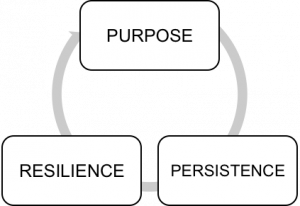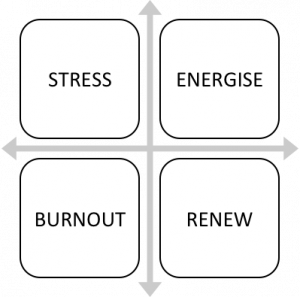How should we coach a client’s lack of motivation? It can be hard to decipher where to begin with the cause or the effect. Catherine Stothart explains
Most coaches have clients who lack motivation at least part of the time. It can be a tricky area to coach around. Cause and effect can be difficult to sort out in a complex situation – am I stressed because I’m demotivated, or am I demotivated because I’m stressed? Which comes first and which should we deal with?
We tend to coach the client to deal with the issues they present – stress, work-life balance, time management, difficult relationships – rather than address motivation directly. While these issues are important, dealing with them does not automatically result in feeling motivated. In fact, discussing them can sometimes be counter-productive, leading the client into a downward spiral. It can be more helpful for the client to switch the focus to what motivates and energises them. If they’re energised, they can deal with the things that drain their energy more easily.
So, what is motivation and how can you coach for it?
What is motivation?
We often think that motivation is about having a sense of purpose, something to get us out of bed in the morning. This is true, but it is only part of it. Motivation is a combination of purpose plus persistence and resilience (Figure 1). When coaching for motivation, you’ll need to work in all three areas: What gives your client their sense of purpose? What enables them to persist despite difficulties? What makes them resilient to bounce back after setbacks?
Figure 1: Motivation: Purpose, Persistence, Resilience
Coaching for purpose
Purpose is something meaningful to you which moves you to action. It can be short-term and changeable or something more stable and enduring, related to our core psychological needs. As a coach, you can help your client clarify the purpose of their role and how it fits into the wider purpose of the team or organisation. You can also raise their awareness of the core needs that drive their behaviour, and of how they meet them in the different parts of their life.
I discuss the four core needs described by Ryan & Deci 1 and Maslow 2 and from temperament theory 3.
Our need to:
- feel competent and good at what we do
- have some choice and freedom over our work and life
- have connections with others and feel that we belong
- fulfil our potential.
Enjoy/Do Well Matrix
I use the Enjoy/Do Well matrix 4 to get my clients thinking about which aspects of their jobs they enjoy or not, and do well or not. This helps them realise what motivates or drains them and what they can do about it. It opens a discussion about whether and how they meet their core needs at work, and what they could change to better meet those needs (Figure 2). They work out how to find their motivation by applying their strengths and meeting their core needs through their work.
ENJOY DON’T ENJOY
Do Well Talents – plan to do more? Plan to reduce or change?
Don’t Do Well Potential strengths – plan to develop? Plan to fix!
Figure 2: Enjoy/Do Well Matrix
Wheel of Life
I sometimes use the Wheel of Life 5 to enable clients to explore how they fulfil these needs for competence, belonging, freedom and potential in the different parts of their life, and where they might want to make changes.
Coaching for persistence
Persistence is to “continue firmly or obstinately in an opinion or a course of action in spite of difficulty or opposition” (OED). The focus here is on keeping going, sustaining effort, during the task. How we think and feel has a huge impact on our persistence. Persistence comes from managing your thoughts, beliefs and emotions to stay positive and confident. You can work with your client on how they feel and think.
Reframing
Timothy Gallwey wrote: “Performance equals potential minus interference” 6 – with the interference coming from our own thoughts and emotions. You can help your client reframe their unhelpful, confidence-sapping thoughts, turning them into more realistic, confidence-building ones. This enhances their self-belief and enables them to persist (Figure 3).
Unhelpful thoughts Replace with helpful thoughts
————————– ——————————————-
————————– ——————————————-
————————– ——————————————-
Figure 3: Reframing thoughts
Setting process goals instead of outcome goals
What often works is to think about the process (ie, what your client can control), rather than the outcome (which they can’t control). A person going for the job interview can’t guarantee they will get the job, but they can give themselves the best chance by preparing well for it.
Attributing success and failure
How we talk to ourselves about our successes and failures is important for maintaining persistence. If we attribute success or failure to things we can control, this leads to more helpful thoughts, rather than attributing it to luck or other random factors 7. You can help your client to review events using Kolb’s Learning Cycle 8. This gives them a sense of agency and empowers them to take action (Figure 4). You can also encourage your client in positive self-talk and suggest they write down three positive things at the end of every day. This builds persistence.
What went well? What didn’t go so well?
What did you learn? What would you do differently next time?
————————– ——————————————————
————————– ——————————————————
————————– ——————————————————
Figure 4: Applying the Learning Cycle
Coaching for resilience
Resilience is “The ability to bounce back from the challenges and setbacks that life throws at us and maintain a positive outlook” (OED). Resilience is about what you do outside the task, rather than in it – how you recharge and recover from setbacks to get going again. It is building your physical, mental and emotional energy so you have enough resources to deal with stressful situations.
Managing energy
Resilience comes from looking after all aspects of yourself. When we have physical, mental, and emotional energy, we’re more likely to feel motivated and maintain momentum. We also have a greater sense of wellbeing.You can use a quiz 9 or checklist to help your client become aware of how well they manage all aspects of their energy.
Figure 5 10 illustrates daily fluctuations in emotional energy: at the top, higher intensity feelings; at the bottom, lower intensity; on the right, positive feelings; and on the left, negative feelings. You can work with your client to identify when their feelings are moving from right to left and what practical actions can help them re-energise or renew.
Figure 5: Emotional energy
Finally….
When you coach motivation, you also coach wellbeing because “happiness comes from using your signature strengths in the main realms of your life” 11. What could be more important than that?
References
1 R Ryan and L Deci, ‘Self-Determination Theory and the Facilitation of Intrinsic Motivation, Social Development, and Well-Being’, in American Psychologist, 55(1), 68-78, 2000
2 A Maslow, ‘A theory of human motivation’, in Psychological Review, 50, 370-396, 1943
3 Temperament theory. See: D Keirsey and M Bates, Please Understand Me: Character and Temperament Types, Del Mar, CA: Prometheus Nemesis, 1978; L Berens, Understanding Yourself and Others™, Radiance House, 2010; and Exploring Essential Motivators™ : https://bit.ly/3H2rS1S
4 C Stothart, Motivation: The Ultimate Guide to Leading Your Team, p32, Routledge, 2022
5 https://positivepsychology.com/wheel-of-life-coaching/
6 T Gallwey, The Inner Game of Work: Overcoming Mental Obstacles for Maximum Performance. New York: Texere, 2000
7 N Zinsser, The Confident Mind: A Battle-Tested Guide to Unshakeable Performance. London: Cornerstone Press, 2022
8 D A Kolb, Experiential learning: experience as the source of learning and development. Englewood Cliffs: Prentice Hall, 1984
9 C Stothart, How to Get On With Anyone, p224. Pearson, 2018
10 J Russell, ‘A Circumplex Model of Affect’, in Journal of Personality and Social Psychology, 39(6), 1161-1178, 1980
11 C E Izard, (1993) ‘Four systems for emotion activation: cognitive and non-cognitive processes”, in Psychological Review, 100(1)
About the author
- Catherine Stothart is a leadership coach working with multinational companies including Airbus and Google. Her best-selling first book, How to Get On with Anyone (2018, Pearson), is a guide to understanding others and communicating with confidence and charisma. It has sold over 11,500 copies and is translated into five languages. Her latest book, Motivation: The Ultimate Guide to Leading your Team, sets out how to lead others to fulfil their purpose and potential (2022, Routledge).


